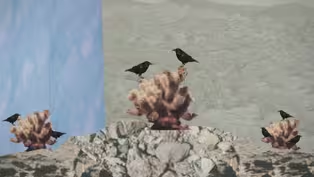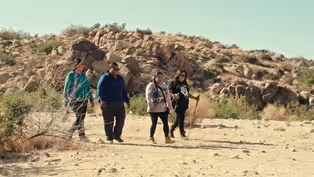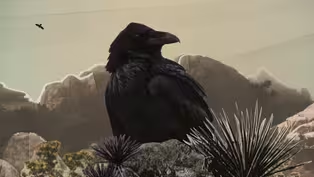
Ravenville: Why Birds Flock to Desert Human Wastelands
Clip: Season 5 Episode 3 | 7m 35sVideo has Closed Captions
Desert biologists find non-lethal solutions to control surging raven populations.
Scientists at Hardshell Labs have been studying raven behaviors for decades. Using GPS trackers, they found that ravens tend to gather near landfills, compost centers, and particularly around a water sewage treatment plant they call Ravenville. They are finding non-lethal solutions to address the correlation between the growth in raven populations and the growth of human activities in the desert.
Problems playing video? | Closed Captioning Feedback
Problems playing video? | Closed Captioning Feedback
Earth Focus is a local public television program presented by PBS SoCal

Ravenville: Why Birds Flock to Desert Human Wastelands
Clip: Season 5 Episode 3 | 7m 35sVideo has Closed Captions
Scientists at Hardshell Labs have been studying raven behaviors for decades. Using GPS trackers, they found that ravens tend to gather near landfills, compost centers, and particularly around a water sewage treatment plant they call Ravenville. They are finding non-lethal solutions to address the correlation between the growth in raven populations and the growth of human activities in the desert.
Problems playing video? | Closed Captioning Feedback
How to Watch Earth Focus
Earth Focus is available to stream on pbs.org and the free PBS App, available on iPhone, Apple TV, Android TV, Android smartphones, Amazon Fire TV, Amazon Fire Tablet, Roku, Samsung Smart TV, and Vizio.
Providing Support for PBS.org
Learn Moreabout PBS online sponsorshipThe emerging toolkit of non-lethal solutions also includes innovative work by scientists at Hardshell Labs.
After tagging ravens with GPS trackers, they've created maps of their behavior, revealing the true scale of the problem, and it's led them to a hot spot, a place they call Ravenville.
[music] The ravens around the rest of the world, they're often known as harbingers of wilderness because they're just out in the middle of the forest as just an individual pair.
You might see two or three or four of them flying around, but here you just see hundreds of them and they particularly thrive in that human wildland interface, not in the desert wilderness.
We'll see individuals there sometimes, but not in large numbers.
We really had to focus on finding better ways of keeping them away from landfills, but also keeping them away from a lot of other sources of, particularly food, and to a certain extent water.
This map is showing a heat map of the locations where we have found one particular radiotransmitted raven.
The red color is where that raven has spent most of its time.
The yellow is where it's spent some time, but not as much, and the green is where it has spent less time.
This is the Victor Valley Wastewater Recovery Authority sewage ponds, and The American Organics Industrial Compost Center is right here.
You can see ponds and things below the green color.
We know that the red area is an area where it's eating because that's right at the-- [crosstalk] -That's right.
-That overlaps American Organics.
-Yes.
It could just be where it likes to hang out during the day.
-Right, if it is not nesting.
-Right.
Putting GPS transmitters on these birds has opened a window into their world.
The surprise was there weren't a lot of surprises.
They did pretty much exactly what I expected.
What I envisioned them to do, they did it.
They went to dairies.
Dairies are a major subsidy.
They went to the nearby dump.
They went to a waste transfer facility.
All of that was predictable, and it was reassuring that, "Okay, they have drawn us maps that essentially will be the basis of regional raven subsidy denial planning."
It's great.
It's just like you pop this solar-powered thing on the bird and they're telling you what to pay attention to.
[music] It's very fragrant.
So there it is.
-Oh, man.
-Fats, oils, and grease, my friend.
-Got it.
-That's some fog right there.
-That is just so lovely.
-Yes.
It's a cornucopia for ravens.
Our interest as human beings running a sewage treatment plant is to get the fats, oils, and grease out of the system so that the bacteria can work on everything else.
That's where the ravens come in and go, "Oh, it's floating calories."
Everything that gets flushed and washed down the drain comes through here.
I'll just let the visual metaphor speak for itself, but they have to get rid of the solids before they can work on the liquids, and of course ravens have figure out, "Oh, okay, there's good food bits in here."
There we go.
What was it?
I don't even know what that is.
I do.
What was cool this winter when we came in, ravens had stuffed old paper towels in that spiky Nixalite up to the point where they could comfortably sit on top of it, and pull the stuff out.
That guy we watched, he was over here and I also saw him up on that scraper thing They're smart, very adaptable, highly variable.
They're fascinating birds.
It's really been a joy studying them for 33 years.
It's too bad that the reason I'm studying them is so that we can reduce their numbers.
Part of my motivation for some of the work that we're doing now is because the work that we're doing is for non-lethal reduction.
That way, we're not going out and killing them.
We're basically using their behavior against them.
That makes it an interesting intellectual challenge.
One of the ways that we're using their behavior against them is by using lasers.
We've found that ravens are super sensitive to particularly green laser light.
We're using lasers to chase them out of agricultural fields like pistachio groves, to chase them out of sewage ponds and compost centers.
Going out.
There it is on the far bank.
Lasers are not hurting the birds.
It's not like a heat laser that burns when it touches you, it's just light.
They're at a distance so it might flash by, but it's just a really quick flash and it works really well.
I'm going to sweep over and hit that set to the left a little bit.
There they go.
Right there he goes down in the bushes.
You're not going to get away from me.
Here's the basics of raven repulsion with lasers and it's non-lethal.
We're not hurting them, but we're getting rid of a problem without having to get rid of the birds.
The default setting a lot of times is, "Oh, let's just kill them."
If you kill them, then everybody's ignorant.
If you train them, some of the birds know what's up.
Another technology that we're using is, it's called egg oiling.
It tricks the ravens into thinking that they're still incubating a viable egg.
They'll sit there and they'll sit there sometimes for several weeks thinking that the egg is eventually going to hatch.
What that does is it brings them so late into the breeding season that it's too late for them to lay a new clutch of eggs.
We've oiled well over 1,000 eggs.
There's evidence now that in the desert, the numbers of ravens are going down, probably as a result of the egg-oiling.
At this point, when there's an emergency going on, you don't want to be modest, you want to be bold.
Give it a shot.
Maybe it doesn't pan out.
If it doesn't pan out, it doesn't pan out.
I have learned to not underestimate the potential of cooperating human beings to solve problems.
We invented egg oiling and egg oiling is now proving out to be an effective way to reduce the pressure ravens are putting on tortoises and other desert wildlife.
Very few biologists ever get to say something like I just said, which is, "Dang, we made this up and it's working."
Video has Closed Captions
Clip: S5 Ep3 | 1m 10s | The history of the raven in both culture and nature is complex. (1m 10s)
Desert Ravens: A 'Major Relative' to Indigenous Traditions
Video has Closed Captions
Clip: S5 Ep3 | 4m 28s | For Indigenous peoples of the Mojave, ravens are powerful, respected elders. (4m 28s)
The Tortoise, the Raven, and Us (Preview)
Video has Closed Captions
Preview: S5 Ep3 | 30s | Ravens threaten Mojave Desert tortoises, and solutions call on shifts in human behavior. (30s)
Providing Support for PBS.org
Learn Moreabout PBS online sponsorshipSupport for PBS provided by:
Earth Focus is a local public television program presented by PBS SoCal


















